| ART IN THE DIGITAL WORLD |
 |
|
Since the dawn of the digital age, the definition of and approach to art has been in flux. There has been disagreement between nouveau artists and traditionalists as to what new styles constitute art, and concern over what will become of art and the consumption of art in this new era of mass production and purely digital creations.
In this article, however, we will avoid the arguments and instead assume, for clarity's sake, that "digital art" is art made with the use or aid of a computer, and identified as art by the creator.
We will consider the different methods and styles followed by digital artists, as well as the effect on art created prior to the digital age, and art created with more traditional methods alongside it.
|
SUMMARY
| COMPUTER ART HISTORY |
DIGITAL SHARING OF ART |
DIGITAL DISPLAY OF ART |
| Art created with the aid or exclusive use of computers began in the 1950s, and the first dedicated exhibits were held in the 1960s. Each new decade saw a wealth of new technology which furthered the progress of digital art. |
Today, all art can be shared through digital mediums such as Facebook and email. Whether the original was made in 2012 or 1712, people all over the world can view millions of artworks with just a click of the mouse. |
Such is the integration of digital media that some art enthusiasts and artists never see their works on paper. Using a digital camera or Adobe Illustrator, artists create their work and then transfer it directly to the Internet. |
|
| COMPUTER ART HISTORY
|
 |
Also known as "graphic art", " digital art", or "new media art", the computer arts include all imagery created with or on a computer, or in which a computer played a considerable role. This encompasses:
- Computer graphics - logos, special effects
- Digital installation art - large-scale, public art
- Generative art - more computer influence than artist, autonomy
- Computer illustration - computerized method of creating "fine" art: paintings, sketches, designs, etc.
No doubt forward-minded artists have come up with any number of other categories which could be placed neatly below the heading of Computer Art. Though we generally think of pieces created in the last decade or so, artists first began to dabble in this inherently contemporary art style in the 1950s.
The advent of this new wave of artistic exploration raised questions as to whether art created by a computer could attain the expression and meaning so sought after in traditional art. The abundance of successful digital artists seem to have proven the answer is yes.
1960s
The first art show dedicated to computer art was held in 1965, following about a decade and a half of digital art. The New York exhibit was titled "Computer Generated Pictures," and was followed by a second show in London in 1969. The work shown in these early exhibits was primarily a collection of random geometric shapes which were fascinating not so much because of their visual effect but because their execution was utterly unique.
Perhaps surprisingly, the digital stylus that allows artists to "draw" directly onto the computer was invented already in the 1970s. David Hockney (b. 1937) was one artist who experimented with this process.
1970s
The 70s also saw a rise in the use of computers to assist the creation of art, as opposed to constructing the image completely on a screen. One artist, Harold Cohen (b. 1928) built the artificial intelligence computer program AARON, which autonomously generated art. When he first began experimenting with automatic art creation, the program did not handle color well, so he printed out his outlined designs and colored them in by hand.
In the early 70s, the Slade School of Art at the University of London developed the "Experimental and Computing Department." It was one of the first schools to integrate computers with the study and teaching of art.
In 1976, the inkjet printer was invented, which gave artists a new medium to translate their computerized designs into something more widely accepted as a carrier of art: paper.
1980s and 1990s
With the rise of virtual realities, interactivity became a facet of computer art. Programs like Adobe's Illustrator (created 1982) allowed artists to create vector drawings, and is still one of the most popular digital art programs today.
Photomanipulation, previously carried out in a darkroom with painstaking trial and error processes, moved to the computer, with artists like Canadian Jeff Wall using Photoshop to alter or finetune their images.
Three-dimensional computer art also gained momentum. Well-known architect Frank Gehry developed the architectural style Deconstructivism, which was inspired by - and often used - computer software to design asymmetrical, geometric, buildings which were primarily constructed in modern materials like metal and glass.
Of course, the creation and subsequent explosion of the Internet has played a substantial role in digital art. New programs like the Deep Dream Effect are being developed regularly, offering exciting possibilities for artists and hobbiests alike.
|
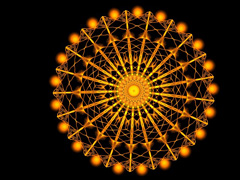
Geometric abstract digital art
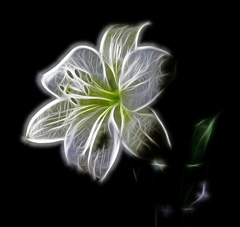
Representational/abract digital art
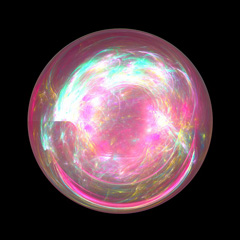
Photorealism abstrction, digital
|
| DIGITAL DISSEMINATION OF ART
|
 |
|
Continuous improvements in imaging methods and the Internet have made a huge difference in the way art is advertised, viewed, and shared. Artists can display their art on a vast number of platforms, broadening their reception by millions. Through blogs, art review sites, art print businesses, and online retail stores, an artist can reach their target audience within days, or even hours.
But digital art is not the only art style that has been altered by advances in computer programs. Art created in traditional methods - both before and after the advent of computers and printers - can now be scanned using a high quality flatbed scanner or photographed using professional art photography equipment.
These digitized versions of paintings and drawings can shared or, using high quality inkjet printers, Gicée inks, and fine art papers, stunningly accurate reproductions can be made that are often collected and sold with nearly as much vehemence as the original.
Good quality digitization of famous artwork has enabled educational institutions and art lovers who can't afford to travel to see world-famous artwork very much as it looks in real life. In fact, they can study the images even more closely: Consider that visitors to the Louvre can only get so close to the Mona Lisa, and often are blocked by the hordes of others straining to see as well. Not to mention that the original painting has been quite dulled, both with age and the artist's intention.
While one can certainly argue there is no replacement for the original, a digitized version of Da Vinci's masterpiece allows viewers to sit at home, in California, or Mexico, or Australia, and study the fine details of an artwork, the way only a curator or priviledged historian would be able to do with the original.
|
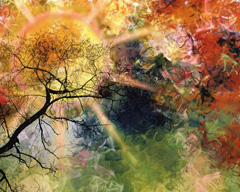
Photo with digital manipulation
|
| DIGITALLY DISPLAYING ART
|
 |
|
Creating art, and producing reproductions, are not the only uses for computers in this digital era. More and more, computers are being used as methods to display the art created on them, not simply as a temporary storage medium before printing.
There is a lot of art - digital photography and computer designs - that never leaves the screen. Artists and art enthusiasts alike create and share images that find their way to personal or professional blogs, stock photo sites, Flickr, and countless other locations, and never exit the digital sphere. Art exhibits are held completely online - even though museums like the Smithsonian.
Artists may make money without their images ever departing the airwaves - stock photo sites sell their pictures or illustrations to companies who use them for their website or email newsletters. Other artists show their work only online, and don't print it until someone places an order.
There are many people who make a living as Instagram or mobile photographers - a group who have long been ostracized from the professional field, but whose time seems to have come. Other photographers still use digital SLR cameras, but the need for enough mega pixels to print a five by six foot reproduction diminishes in some circles, since their work might only be used online.
Computer screens in private homes and offices aren't the only examples of digital art viewing. Some museum and art gallery contemporary exhibits feature the installation of multiple computer screens which show art intended only for digital consumption.
At the recent "Disguise" exhibit in Seattle, WA, artist Brendan Fernandes showed his 2010 work "Dada Afrika IV", which involved monitors hung at eye level, on which simplified, flashing images reminiscent of African masks were cued with voices heard through accompanying headphones.
Other artists create digital or video sequences that are projected on twelve-foot gallery walls. These works will never be stationary, framed behind glass, but they are becoming just as significant and valuable as the paintings and charcoal drawings that came before.
|
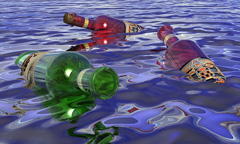
Digital realism, often only viewed on a monitor
|
|
Digital art appears to be here to stay in our creative environment. At KeenART Media, we appreciate that digitization of artwork makes it easier and swifter for us to create beautiful reproductions on canvas and fine art papers. Our clients simply upload their digital images and can have their prints within a few days.
We employ a talented graphic designer who can retouch and fine-tune your photographs and artwork, as well as apply a wide range of image effects.
If you have questions about any of our services or products, don't hesitate to contact us. Our knowledgeable staff is always happy to assist with answers, advice, or suggestions.
For more information on Computer Arts: Art Encyclopedia, Victoria and Albert Museum
(All artworks shown on this page are public domain stock images. Hover over images to see the uploader's user name.)
|
|
© 2002-2024 - KeenART Media Ltd.
|
|
| |
|

